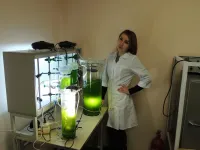(Press-News.org) Plastics made from crops such as maize or sugarcane instead of fossil fuels are generally considered sustainable. One reason is that plants bind CO2, which compensates for the carbon released into the atmosphere when plastics are disposed. However, there is a catch: With increasing demand for raw materials for bioplastic production, the areas under cultivation may not be sufficient. As a result, natural vegetation is often converted to agricultural land and forests are cut down. This in turn releases large amounts of CO2. The assumption that more bioplastics does not necessarily lead to more climate protection has now been confirmed by researchers at the University of Bonn (Germany) in a new study. They found that the sustainability of plant-based bioplastics depends largely on the country of origin, its trade relationships and the raw material processed. The study has been published in the journal "Resources, Conservation & Recycling".
As in previous analyses, the scientists used a global, flexible and modular economic model developed at the University of Bonn to simulate the impact of rising supply for bioplastics. The model is based on a world database (Global Trade Analysis Project). For their current study, the researchers modified the original model by disaggregating both conventional plastics and bioplastics, as well as additional crops such as maize and cassava. "This is crucial to better represent the bioplastics supply chain in major producing regions and assess their environmental impacts from a life cycle perspective," emphasizes agricultural engineer Dr. Neus Escobar, who conducted the study at the Institute for Food and Resource Economics (ILR) and the Center for Development Research (ZEF) at the University of Bonn and is now based at the International Institute for Applied Systems Analysis in Laxenburg (Austria).
In the current study, she and her colleague Dr. Wolfgang Britz considered the loss of natural vegetation on a global scale. They made estimates of readily available land to be converted into productive uses at the region level and associated model parameters. In their previous publication, the Bonn scientists had already disaggregated the production of conventional plastics and bioplastics in Brazil, China, the EU and the U.S. - the countries that lead the way in bioplastics production. In their current study, they also included Thailand, which is home of carbon-rich forests. Experts expect the Asian country to become a leading global producer of biodegradable and biobased plastics in the near future. "All these changes in the model are necessary to estimate global spillovers of policies or technologies," says Dr. Wolfgang Britz, who worked with his team on the extension of the model to derive sustainability indicators considering global land use change.
Factors such as country of origin and raw materials are decisive
The researchers simulated a total of 180 scenarios (36 scenarios per region) that varied according to the degree of bioplastics market penetration and other model parameters determining economywide responses. "We found that the carbon footprints of commercially available bioplastics are much larger than the values previously estimated in scientific literature and policy reports," says Neus Escobar.
The reason: CO2 emissions resulting from changes in land use outweigh the greenhouse gas savings resulting from the substitution for fossil raw materials in the long term. With one exception, the bioplastics produced in Thailand save an average of two kilograms of CO2 per ton. This is mainly due to the relatively smaller increase in bioplastics production that is simulated, which translates into minor adjustments in food prices and associated land cover changes. However, increasing production of bioplastics from cassava and sugarcane in Thailand to catch up with the other regions can result in the loss of carbon-rich ecosystems within the country.
None of the regions is clearly better positioned than another
The overall calculations show that none of the regions is clearly better positioned than another to become a hub for sustainable bioplastics production. The largest land footprints are estimated for Chinese bioplastics, while the European Union has the largest average carbon footprint: Bioplastics produced in the EU take an average of 232.5 years to offset global CO2 emissions. Bioplastics production in the U.S. causes the greatest land and carbon spillovers, which means that the production generates greater agricultural land expansion, deforestation and carbon emissions in the rest of the world than within the country. Bioplastics production in Thailand and Brazil comes at the cost of forest cover loss to a large extent, which can lead to additional impacts on biodiversity.
"Our study shows that an expansion in bio-based production should be carefully assessed on a region-by-region case in order to understand potentially sustainability risks and trade-offs," says Neus Escobar. The authors emphasize that the proposed metrics can be used in the future to monitor the long-term sustainability of bioeconomic interventions globally. Among other things, the metrics could help identify where complementary policies are needed - for example, to prevent deforestation.
Working on future-relevant research topics
The study is thematically embedded in the Transdisciplinary Research Area (TRA) "Innovation and Technology for Sustainable Futures" at the University of Bonn. In six different TRAs, scientists from a wide range of faculties and disciplines come together to work on future-relevant research topics. Neus Escobar was a member of the Transdisciplinary Research Area during the study, Wolfgang Britz is a member of the "PhenoRob" Cluster of Excellence at the University of Bonn.
INFORMATION:
Publication: Neus Escobar & Wolfgang Britz: Metrics on the sustainability of region-specific bioplastics production, considering global land use change effects. Resources, Conservation & Recycling; DOI: 10.1016/j.resconrec.2020.105345
A study from the Center for Phage Technology, part of Texas A&M's College of Agriculture and Life Sciences and Texas A&M AgriLife Research, shows how the "hidden" genes in bacteriophages -- types of viruses that infect and destroy bacteria -- may be key to the development of a new class of antibiotics for human health.
The study has been published in Nature Communications and Current Science Daily, as well as featured in a recent Nature Research Microbiology Community blog post.
The need for new antibiotics
Antibiotic-resistant bacteria pose ...
Primeval forests are of great importance for biodiversity and global carbon and water cycling. The three-dimensional structure of forests plays an important role here because it influences processes of gas and energy exchange with the atmosphere, whilst also providing habitats for numerous species. An international research team led by the University of Göttingen has investigated the variety of different complex structures that can be found in the world's forests, as well as the factors that explain this diversity. The results have been published in Nature Communications.
The researchers investigated the structure of primeval ...
A vegan diet is more effective for weight loss than a Mediterranean diet, according to a groundbreaking new study that compared the diets head to head. The randomized crossover trial, which was END ...
Rain falls lightly on the ocean's surface. Marine mammals chirp and squeal as they swim along. The pounding of surf along a distant shoreline heaves and thumps with metronomic regularity. These are the sounds that most of us associate with the marine environment. But the soundtrack of the healthy ocean no longer reflects the acoustic environment of today's ocean, plagued with human-created noise.
A global team of researchers set out to understand how human-made noise affects wildlife, from invertebrates to whales, in the oceans, and found overwhelming evidence that marine fauna, and their ecosystems, are negatively ...
In the framework of the Chlorella microalgae cultivation process, the researchers from Peter the Great St.Petersburg Polytechnic University (SPbPU) obtained microalgae biomass with a high content of carotenoid pigments, which is suitable for the food industry. The research results were published Nov. 2020 in the scientific journal "Agronomy Research".
The deterioration of the ecological status of urban areas and the industrialization of the food industry requires the additional enrichment of the diet with biologically valuable food substances. Such pigments as carotenoids, from which vitamin A is synthesized in the body, are ...
Astronomers have for the first time used distant galaxies as 'scintillating pins' to locate and identify a piece of the Milky Way's missing matter.
For decades, scientists have been puzzled as to why they couldn't account for all the matter in the universe as predicted by theory. While most of the universe's mass is thought to be mysterious dark matter and dark energy, 5 percent is 'normal matter' that makes up stars, planets, asteroids, peanut butter and butterflies. This is known as baryonic matter.
However, direct measurement has only accounted for about half ...
Using AI and computer automation, Technion researchers have developed a "conjecture generator" that creates mathematical conjectures, which are considered to be the starting point for developing mathematical theorems. They have already used it to generate a number of previously unknown formulas. The study, which was published in the journal Nature, was carried out by undergraduates from different faculties under the tutelage of Assistant Professor Ido Kaminer of the Andrew and Erna Viterbi Faculty of Electrical Engineering at the Technion.
The project deals with one of the most fundamental elements of mathematics - mathematical constants. ...
When treating cancer, researchers are always searching for ways to remove cancer cells while minimizing damage to the rest of the body. One possible approach is to find processes unique to cancer cells, and which would allow specific targeting. If such a process can be disrupted, only those cells would be affected.
A process (or absence thereof) can be unique to some types of cancer, and not be present in others. In such a case, we would want a simple way to recognize whether a particular tumor possesses the unique trait or not. The implication of this question is whether the tumor would respond to ...
Researchers from the HSE Institute for Cognitive Neuroscience have proposed a new method to process magnetoencephalography (MEG) data, which helps find cortical activation areas with higher precision. The method can be used in both basic research and clinical practice to diagnose a wide range of neurological disorders and to prepare patients for brain surgery. The paper describing the algorithm was published in the journal NeuroImage.
Magnetoencephalography (MEG) is a method based on measuring very weak magnetic fields (several orders of magnitude weaker than the Earth's magnetic field) induced by the brain's electrical activity. When using MEG, researchers face the complicated task ...
Professionalisation in any field requires long-term experience and training. In the past decades, studies have demonstrated that the professionalisation of athletes and artists create differences in the behaviour of the brain while carrying out activities related to their area of expertise.
To detect the effects of media professionalisation in the brain, a research team from the Universitat Autònoma de Barcelona, the Instituto Ràdio Televisió Espanyola and the Universidad Pablo de Olavide in Seville conducted a study published in Frontiers in Systems Neuroscience in which audiovisual contents were presented to a group of media ...



